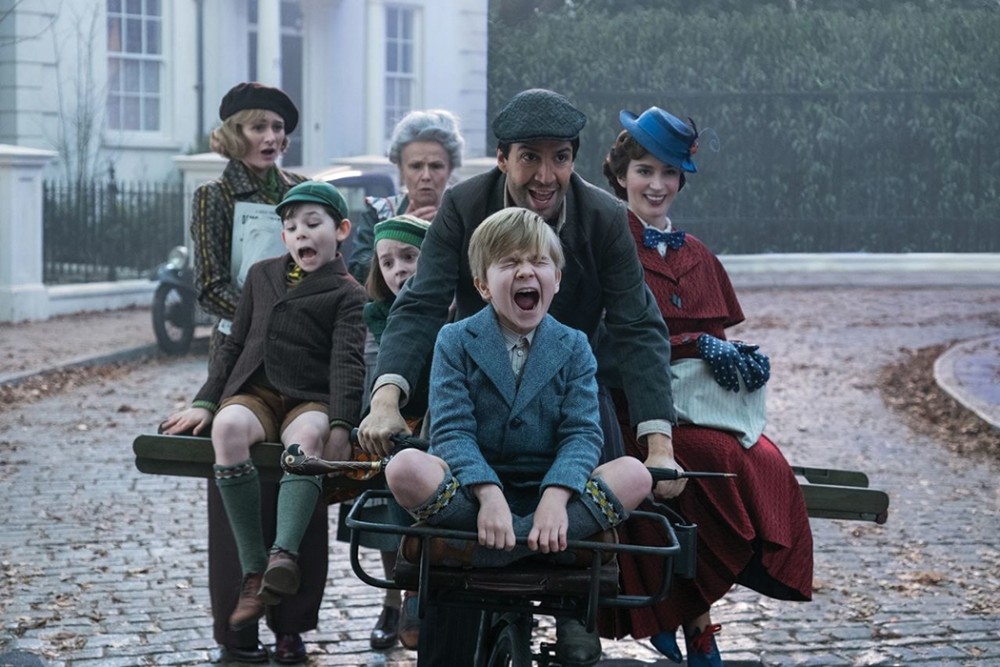Mary Poppins returns to a world of economic insecurity
Can memories of childhood joy really make up for predatory lending and labor busting?

The 1964 film Mary Poppins taught a generation a new way to think about childhood. Mary Poppins’s transformation into a Disney heroine represented a departure from the much sterner, sometimes cruel, and vain nanny figure of the original books, written by Australian-British writer P. L. Travers in the 1930s. The film also helped solidify the cultural fantasy that remembering the magic of childhood is a way to overcome the stultifying effects of rational, bureaucratic life.
The newly released sequel Mary Poppins Returns (directed by Rob Marshall) sings this same song in a new key, but it rings a little hollower 55 years later. We may need more than magical childhoods to cure what ails us now.
The sequel opens in the midst of the Great Depression a few decades after the original movie ends. Jane Banks (Emily Mortimer) has become a union organizer, and her brother Michael (Ben Whishaw) is now a down-on-his-luck widower raising three children in their family home. To compound his woes, he took out a loan on the house to pay his wife’s medical bills and the note has come due.
Read our latest issue or browse back issues.
The death of a spouse, worldwide economic depression, and near-certain foreclosure would be enough to put a cramp in anyone’s parenting style, so Michael might be forgiven for being a little depressed and distracted. But Mary Poppins (Emily Blunt) specializes in reforming distant fathers, and she once again blows in on a strong wind to set things right with her unique blend of no-nonsense love and magic.
The 1964 film was set in Edwardian England, where Mr. Banks ran his home like an outpost of the British empire. Mary Poppins’s job was to teach Mr. Banks how to parent beyond commanding his children’s obedience. A lot of magical hijinks and memorable music ensue, but the culminating transformation comes when Mr. Banks loses his job to find his soul. He flies a kite, regains his job (with a promotion!), and presumably settles down to a more benevolent rule.
This time round, it is the children who have adopted world-weary adult burdens, picking up the slack for their dead mother as their father muddles through in a cloud of depression. Mary Poppins has to teach the children how to be children again and snap Michael out of his funk in time to save the family home and remember the wonder of childhood. More magical hijinks ensue, and it feels like the plot of the first movie has been remade beat for beat. I am not sure any of these songs will be as memorable as the originals, but the performances are delightful, the dance sequences are enthralling, and my Hamilton-obsessed eight-year-old could have watched Lin-Manuel Miranda—who plays Jack the lamplighter, in an update of Dick Van Dyke’s role as Bert the chimney sweep—swing around a lamppost all night.
But there is a much darker edge to the sequel. While the central messages of the film remain “look up,” “hold on to those we love,” and “don’t forget the magic,” an adult viewer can’t quite imagine that these dictums will actually save the family.
In the first film, the only real threat to the family is old-world masculinity and workaholism. Amid the economic security and cultural transformation of the early 1960s, a playful contrast could be set up between Mr. Banks’s tightly
buttoned sensibilities and Bert’s jack-of-all-trades artistic freedom. Copious adult fiction of the 1950s and 1960s explored the ennui and despair of corporate suburban life, and much of it ended in death or adultery. Mary Poppins offered a gentler and more family-friendly remedy. Men like Mr. Banks—and their 1960s counterparts—could recapture the joy of life by unbuttoning their collars and playing with their kids.
The same doesn’t hold for grown-up Michael, and probably not for us either. He was at least partially raised by Mary Poppins, after all, and has already imbibed her wisdom. The same might be said of many adults who grew up on the original film. In fact, I found myself wishing Michael had inherited a little more of his father’s level-headed skills at planning so his children did not have to manage his entire life for him. He has been solo parenting for over a year and does not seem to know the price of bread.
Now that economic devastation shadows the family, the suggestion that memories of childhood joy are enough to make up for predatory lending and labor busting feels pretty weak. Better social policy might help that medicine go down.
Both Mary Poppins films view childhood as a lost paradise we should all be striving to recapture. But the next generation of Banks children may have already learned a more important lesson: parental attention alone cannot make up for economic security and a social system worth inheriting. Let’s hope they pay at least as much attention to Aunt Jane’s labor rallies as they do to Mary Poppins’s imaginative songs.
A version of this article appears in the print edition under the title “Is Mary Poppins’s magic enough?”






